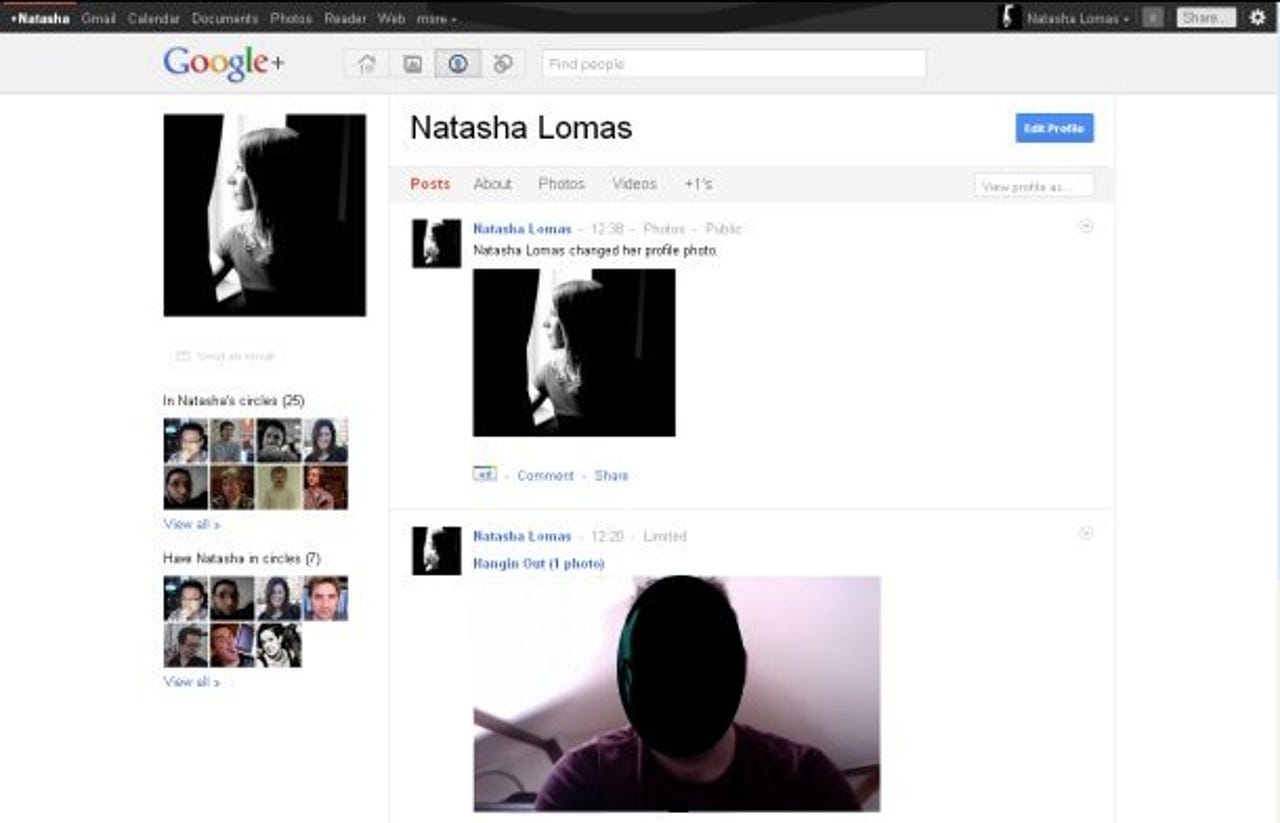Photos: Inside Google+ - how to use Circles, Hangouts, Sparks and more


Google+ Profile
Take a tour of the Google+ private beta - Mark Zuckerberg already has...
Last week, Google took the wraps off its latest social offering, Google+: a collection of new web services and existing tools packaged together to let users share content with the individuals and groups of their choice.
For now, Google+ is in a closed "field trial period" - that is, an invite-only beta and a limited one at that. However, silicon.com managed to get its mitts on a +1 and signed up to the party, screengrabbing the action for your viewing pleasure.
Google+ Profile details
Google+ users must first set up a Google Profile - name and gender is enough to get the ball rolling but you can also give Google lots more data about your life, should you choose, as shown above.
Also displayed on your Google+ profile are any Google+ posts you make and any photos and videos you upload or are tagged in. Your profile shows any web content you give a +1 to as well. +1 is Google's Facebook-Like-style search recommendation feature.
Your profile also displays thumbnails of people in your Circles, in a similar style to Twitter's Following and Followers photos.
Facebook vs Google+
Google+'s three-column Stream page (bottom) distinctly resembles Facebook's three-column News Feed page (top) as the above image demonstrates.
As with Facebook, a Google+ user connects their account with other users' accounts and subjects of interest in order to populate their Stream with content. However, Google+ users can tweak what they see by clicking on individual Circles or Sparks to see only the content being shared in that section.
Google+ Circles
This is where the Google+ world starts to look a bit different to other social networking services.
Google's social network is designed to enable users to group people they know into distinct groups - called Circles - rather than having one massive Friends list, so users can better target content they are sharing. Anything you post to Google+ requires you to specify which Circles or individuals you want to share it with. There's also the option to share content with people who are not on Google+ via email.
Google's Circles system makes adding people to your social network a bit less formal than Facebook's emotive Friend button, by encouraging users to drag and drop people into different Circles. You can create new Circles, and also rename the default suggestions which are Friends, Family and Acquaintances.
Google mines your email history to suggest people you might want to add to Circles. However, the data mining is pretty crude. NO-REPLY@Flickr.com was one of my suggestions, along with unsubscribe@primelocation.com. Not the best contact recommendations I have ever had.
There are also options to find people via Yahoo and Hotmail, although not via Facebook at the moment.
Google+ photos
The second icon of the four on the Google+ nav bar is the photos icon. Here, users can browse a collage of all the photos being shared by people in their Circles, photos they have uploaded, photos tagged with their name and mobile photo uploads.
The page layout is a cross between Flipboard's photo montage feature and Google's own Images search page.
Google+ Sparks
Here's the main Sparks page, where Google+ users can tell Google what topics float their boat. Like fast cars and baking? Just add the Sports Cars and Recipes Sparks to your Google+ account and a pipeline of related content will be fed your way.
Google+ Sparks
Here's a view of a Sparks stream on robotics.
Sparks is where search meets social, giving Google the chance to flex its algorithmic muscle. It can also be described as Google Reader for RSS dummies.
Google+ Hangouts
The standout feature of Google+ has to be Hangouts, a group videoconferencing feature that's a cross between Chatroulette and Apple's FaceTime.
Hangouts allows Google+ users to start a video chat room and tell friends or particular Circles they are in the mood for some face time. Up to 10 people can join the video chat with the main camera view switching depending on who's speaking. Users can also chat via text using an IM window alongside the video feed, similar to Skype.
Google+ IM Chat
Another comms feature built in to Google+ is Google Chat, an instant messaging system that will be familiar to Gmail users as Google recycles another bit of existing functionality.
Facebook has a built-in IM system too of course. Sign in to chat and then hit up any online contacts or Circles who have enabled the feature.
Google+ share link
Sharing content is the lifeblood of any social network.
Here's the view a Google+ user gets, with options to share links, photos, videos and location. Google+ differs from Facebook with its Circles layer, meaning you must specify who exactly you are sharing a post with. The system defaults to the last combination of people or Circles you shared with to save time, or you can add different people or Circles.
Google+ photo tagging
Here's Google+'s photo viewer and photo-tagging feature in action.
Google+ default settings
New Google+ users will quickly find themselves bombarded with notification emails, or SMS if they add a mobile number, such as when another user adds them to a Circle or comments on one of their posts. The deluge comes because the settings check every notification option apart from geolocation by default.
Google+ privacy
On the privacy front, Facebook is frequently criticised for having overly complex privacy settings and for making its users' data open by default. Google+'s privacy settings generally adopt a more cautious stance and the settings page is more straightforward.
Settings that can be edited include the visibility of your profile to search, an option to see how your profile looks to other users, the ability to edit which users are shown as being in your Circles and the ability to edit who can tag you in photos.
Google has also lined up its first privacy-related updates for Google+, including an update that will ensure content intended for a limited group of people cannot be reshared publically.
Google+ Feedback
Here's a reminder that Google+ is still in beta: the Feedback feature allows users to send Google a bug report when something malfunctions by highlighting the problem and then censoring any bits of data they don't want to send to Google. It's a nice privacy-aware touch - even if Google's servers are already storing all that data anyway.
Google+ data liberation
Google is likely to be hoping Data Liberation is another differentiator of its social network vs Facebook, as Google+ is offering users the ability to easily pick up their data and leave from the get-go.
Google+ Mark Zuckerberg
And talking of Facebook, CEO Mark Zuckerberg has scored himself a +1 to the Google party - presumably so he can kick the tyres of his latest social rival.
Google+ mobile
On the mobile front, there's a web app for iPhone users, pictured above, with access to your Stream, Photos and notifications about new Google+ activity. There's a fully fledged iPhone app in the pipeline, "coming soon" according to Google.
Android users don't need to wait of course. The Android app is already on Android Marketplace, offering those Google+ users who have scored a +1 to the closed beta the ability to perform location check-ins, view posts from other Google+ users in their vicinity and Huddle - a real-time group IM feature for mobile users resembling RIM's BlackBerry Messager.